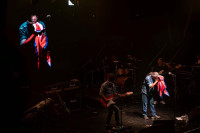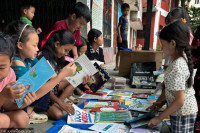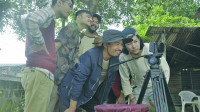Entertainment
The Swayambhupurana: Restoring the Shantipur murals
Even those who have been to the Swayambhu Mahachaitya Complex repeatedly will most likely have missed the nondescript, white plaster and stucco Shantipur temple north of the stupa.
Sophia L Pandé
Even those who have been to the Swayambhu Mahachaitya Complex repeatedly will most likely have missed the nondescript, white plaster and stucco Shantipur temple north of the stupa, out of the way of the usual tourist or religious visit that takes us up the stairs, clockwise around the stupa, stopping for a breath and the view, and then back down again to the parking lot for those slothful enough to have driven up.

In the 2015 earthquake the little known but powerful tantric Shantipur temple was badly damaged. Along with the immense blow to the structure, there was an added layer of devastation—the temple’s inside walls were painted with a narrative mural describing the ancient Swayambhupurana. This vast work is the longest known narrative Buddhist painting in existence and tells the tale of the journey of the various iterations of the Buddha who came to Kathmandu (the Nepal Valley as it was known then) in search of the self-originating holy site (Swayambhu) that appeared in the middle of the thousand petal lotus after the lake that was the Valley was drained.
Between 170-180 metres long and wrapped around the sooty insides of the temple, the narrative painting is usually hidden from sight; Shantipur can only be entered by the Buddhacharya priests and the Thakalis of the temple. Alex von Rospatt, professor for Buddhist and South Asian Studies at the University of California, Berkeley, who gave a lecture on this remarkable painting last week at a talk organised by the Social Science Baha, himself only discovered the existence of the mural in the early 2000s, upon which, with the blessing of the Thakalis, and the aid of Niels Gutschow and his photographer Stanislaw Klimek, the murals were documented in their entirety.
It is this hallmark achievement that now allows for scholars and restorers to set about the daunting task of salvaging what remains of the murals and deciding how and whether or not to put them back in situ. 
During the earthquake, the murals were damaged badly, the priests and caretakers of the temple, unaware of how to sift through the debris began piling it outside the temple. Emergency phone calls were made, and David Andolfatto, an archaeologist working for UNESCO Nepal was called in along with the likes of the late Dina Bangdel, and other eminent, passionate arts lovers and conservationists who helped sift painstakingly through the remains of the mural, the major part of which had fallen from the walls.
As early as May 2, 2015, Andolfatto and his colleagues were on the ground working to salvage what they could, and with the help of the Nepal Army, the pieces were then transported to the National Museum at Chhauni.
More than two years after the earthquake, the main, complex issue at the centre of this important mural that traces its origin back to the reign of Pratap Malla, in the mid 1700s, is whether or not to replace the murals that have been salvaged, and to restore the pieces in patchwork, or perhaps to leave them be in the museum, and using the complete photographic documentation of the Swayambhupurana to repaint the inner walls anew, as they have been every few centuries or so by the care-takers of the temple.
This is both an academic debate and an emotional one. As Professor Rospatt pointed out in his lecture, the paintings themselves are traditionally the property of the King. With a monarchy no longer in place, the question of to whom these murals might belong to is a source of much debate. In the absence of a King, they belong by default to the government and therefore to the people, but the discussion on who should make the decisions are endless.

The works on the walls were last restored in 1904 by a family of Chitrakars, and while the site and the historical value of the narrative is incalculable, the artistic merit of this last restoration lies in the eye of the beholder. Emotionally, it is key to the temple, aesthetically, it is visually awkward, an oddity in a valley of celebrated artisans and artists who are distinguished by their commitment to the fine arts.
In our living culture, as things are broken in places of worship such as in the Hari Shankar temple in Patan Durbar Square, the idol which was cracked during the earthquake may no longer be worshipped and has been removed to the Patan Museum, a new one will be carved and put in its place, the tradition of worship will continue with the aid of an ongoing syncretism that has always existed between community and artisans.
The same argument could be made for the Shantipur murals. The work of restoration now lies in the hands of the renowned restorer Rudolfo Luhan who worked on the famed monasteries of Lo Manthang until 2003, and who was brought in by UNESCO, with approval from the Department of Archeology, to gently remove the remaining murals on the walls (they could not stay, the building is structurally unstable), and now await restoration and perhaps return to where they were before—unless a community of artists come forward with compelling arguments to persuade the Thakalis, the Buddhacharyas, the Department of Archaeology, and all other stakeholders that they have a right to make a new rendition of an old story that is so central to how we perceive our home, the Kathmandu Valley.




 11.12°C Kathmandu
11.12°C Kathmandu










